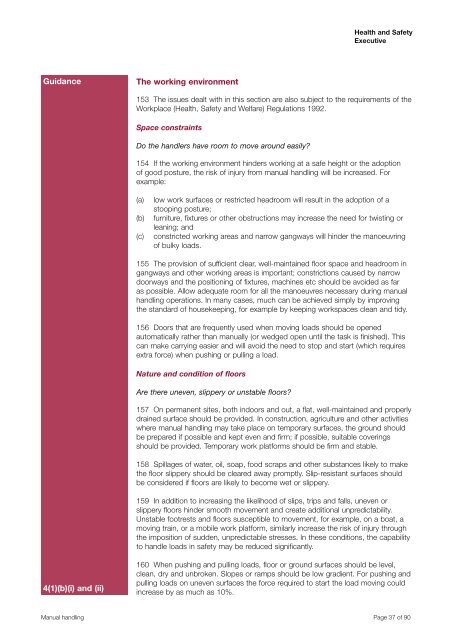Manual Handling Manual Handling Operations Regulations 1992 ...
Manual Handling Manual Handling Operations Regulations 1992 ...
Manual Handling Manual Handling Operations Regulations 1992 ...
You also want an ePaper? Increase the reach of your titles
YUMPU automatically turns print PDFs into web optimized ePapers that Google loves.
Health and Safety<br />
Executive<br />
Guidance<br />
The working environment<br />
153 The issues dealt with in this section are also subject to the requirements of the<br />
Workplace (Health, Safety and Welfare) <strong>Regulations</strong> <strong>1992</strong>.<br />
Space constraints<br />
Do the handlers have room to move around easily?<br />
154 If the working environment hinders working at a safe height or the adoption<br />
of good posture, the risk of injury from manual handling will be increased. For<br />
example:<br />
(a)<br />
(b)<br />
(c)<br />
low work surfaces or restricted headroom will result in the adoption of a<br />
stooping posture;<br />
furniture, fixtures or other obstructions may increase the need for twisting or<br />
leaning; and<br />
constricted working areas and narrow gangways will hinder the manoeuvring<br />
of bulky loads.<br />
155 The provision of sufficient clear, well-maintained floor space and headroom in<br />
gangways and other working areas is important; constrictions caused by narrow<br />
doorways and the positioning of fixtures, machines etc should be avoided as far<br />
as possible. Allow adequate room for all the manoeuvres necessary during manual<br />
handling operations. In many cases, much can be achieved simply by improving<br />
the standard of housekeeping, for example by keeping workspaces clean and tidy.<br />
156 Doors that are frequently used when moving loads should be opened<br />
automatically rather than manually (or wedged open until the task is finished). This<br />
can make carrying easier and will avoid the need to stop and start (which requires<br />
extra force) when pushing or pulling a load.<br />
Nature and condition of floors<br />
Are there uneven, slippery or unstable floors?<br />
157 On permanent sites, both indoors and out, a flat, well-maintained and properly<br />
drained surface should be provided. In construction, agriculture and other activities<br />
where manual handling may take place on temporary surfaces, the ground should<br />
be prepared if possible and kept even and firm; if possible, suitable coverings<br />
should be provided. Temporary work platforms should be firm and stable.<br />
158 Spillages of water, oil, soap, food scraps and other substances likely to make<br />
the floor slippery should be cleared away promptly. Slip-resistant surfaces should<br />
be considered if floors are likely to become wet or slippery.<br />
159 In addition to increasing the likelihood of slips, trips and falls, uneven or<br />
slippery floors hinder smooth movement and create additional unpredictability.<br />
Unstable footrests and floors susceptible to movement, for example, on a boat, a<br />
moving train, or a mobile work platform, similarly increase the risk of injury through<br />
the imposition of sudden, unpredictable stresses. In these conditions, the capability<br />
to handle loads in safety may be reduced significantly.<br />
4(1)(b)(i) and (ii)<br />
160 When pushing and pulling loads, floor or ground surfaces should be level,<br />
clean, dry and unbroken. Slopes or ramps should be low gradient. For pushing and<br />
pulling loads on uneven surfaces the force required to start the load moving could<br />
increase by as much as 10%.<br />
<strong>Manual</strong> handling Page 37 of 90
















